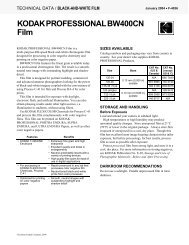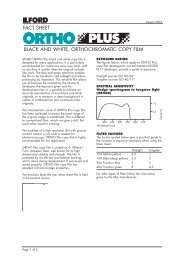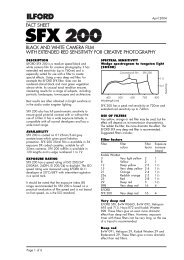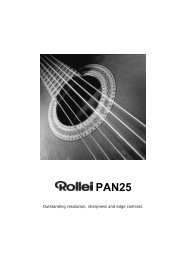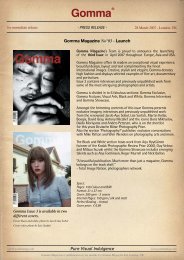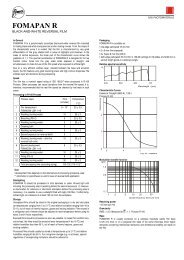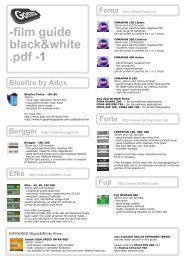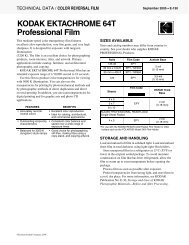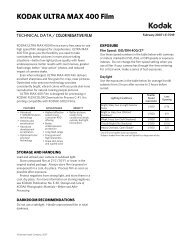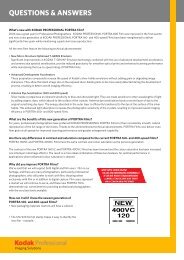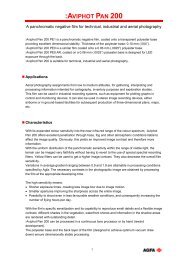films Technical Data - Gomma
films Technical Data - Gomma
films Technical Data - Gomma
Create successful ePaper yourself
Turn your PDF publications into a flip-book with our unique Google optimized e-Paper software.
<strong>Technical</strong> <strong>Data</strong><br />
Range of Agfa standard <strong>films</strong><br />
-1<br />
400 500<br />
This brochure contains information on the quality and features<br />
of Agfa amateur colour <strong>films</strong>. More specific data, figures and<br />
charts are given in the appendix.<br />
Agfa colour <strong>films</strong> are high-grade products for all applications<br />
in amateur photography. The speed ratings available range<br />
from the standard sensitivity, for normal and very bright<br />
conditions, up to high sensitivity for bad to critical lighting<br />
conditions or fast-moving subjects. The optimum material is<br />
therefore available for any situation which may arise in normal<br />
practice.<br />
Agfa Vista 100<br />
Agfa Vista 200<br />
Agfa Vista 400<br />
Agfa Vista 800<br />
Agfa Ultra 100<br />
Agfa APS star 200<br />
Agfa APS star 400<br />
Agfa CTprecisa 100<br />
Agfa CTprecisa 200
General comments<br />
Agfa Vista, Ultra and APS star with<br />
EYE VISION technology<br />
A film's colour rendition is governed by a number of factors. The<br />
emulsions' spectral sensitivity or sensitisation is particularly important,<br />
when it comes to reproducing true-to-nature colours with the maximum<br />
accuracy. By means of the EYE VISION technology incorporated in all<br />
the Agfa Vista, Ultra and APS star <strong>films</strong>, it is now possible to match, to<br />
a large extent, the <strong>films</strong>' sensitisation to the colour perception of the<br />
human eye. The effect is shown schematically in the following diagrams.<br />
The EYE VISION technology achieves more accurate colour fidelity, and<br />
largely eliminates the colour falsifications present in <strong>films</strong> with<br />
conventional sensitisation such as:<br />
• an unpleasant green cast with fluorescent light (e.g. neon tubes),<br />
• a shift towards red in certain blue-coloured flowers (hortensia, clematis,<br />
delphinium etc.),<br />
• the brown rendition of particular green fabric colours,<br />
• the absence of texture in certain red colours (e.g. roses).<br />
spektrale Empfindlichkeit des Auges<br />
Blau Grün Rot<br />
400 450 500 550 600 650 nm<br />
spektrale Empfindlichkeit der Film-Emulsionen<br />
Vista<br />
Ultra<br />
APS star<br />
Blau Grün Rot<br />
herkömmlich<br />
400 450 500 550 600 650 nm<br />
The new Agfa Vista<br />
The secret of the outstanding image quality of the new Agfa Vista is<br />
the even further improved Eye Vision Technology 3.0*<br />
The new Agfa Vista film – even more convenience and reliability by:<br />
• Natural colours<br />
The crucial separation of green and red tones has been improved even<br />
further by the exact placement of substances which operate in and<br />
between the colour layers (inter-image effect).<br />
•Enhanced 3-dimensional quality<br />
To improve the depth and rendering of detail of Agfa Vista 200 the<br />
number of light-sensitive sensors (that is, the silver halide SXM crystals)<br />
has been increased by 30%. A 3-D effect that is almost touchable!<br />
• Improved stability<br />
Whether exposed or unexposed – the stability of the new Agfa Vista<br />
<strong>films</strong> has once again been improved. This was achieved by optimizing<br />
the treatment of the SXM crystals with precious metals (for example<br />
gold, palladium or iridium).<br />
• Better processing stability<br />
The new Agfa Vista <strong>films</strong> contain a new type of scavenger, which<br />
regulates the developing process. This further improves the processing<br />
stability and therefore the reliability of the end result.<br />
Directions for use<br />
Film speed<br />
Today’s ISO values are a combination of the former ASA and DIN<br />
values. The following table illustrates this point.<br />
ISO ASA DIN In comparison to ISO 100/21°<br />
100/21° 100 21°<br />
200/24° 200 24° twice as fast<br />
400/27° 400 27° four times as fast<br />
800/30° 800 30° eight times as fast<br />
In principle, all these speeds are for all photographic situations that<br />
might occur under normal circumstances (e.g. people, portraits,<br />
landscapes, groups, buildings, holidays, animals, plants, flowers,<br />
documentation etc.). Nevertheless, it is still worthwhile observing a<br />
number of simple rules in the choice of the film speed.<br />
ISO ISO ISO ISO<br />
100/21° 200/24° 400/27° 800/30°<br />
Lighting<br />
– Bright, e. g. cloudless × ×<br />
– Medium, e. g. overcast × ×<br />
– Weak, e. g. dawn × ×<br />
Moving subject*<br />
– Almost motionless × ×<br />
– Medium-fast × ×<br />
– Fast × ×<br />
Lens*<br />
– High speed × ×<br />
– Low speed × × ×<br />
Flash (medium light output)<br />
– Small rooms × ×<br />
– Large rooms × ×<br />
* Depending on the lighting<br />
Camera setting<br />
Modern cameras adjust themselves automatically to the film speed (by<br />
reading the DX code). Cameras without automatic lighting control<br />
must be set manually to the film speed stated on the pack.<br />
Exposure latitude<br />
Most cameras have automatic exposure control, which sets the most<br />
favourable ratio of exposure time and aperture. Nevertheless, many<br />
photographs are not correctly exposed, because the automatic control<br />
of some cameras cannot cope with unusual or critical lighting conditions.<br />
Backlit shots are a typical example. Without lighting adjustment, the<br />
negative or slide may well end up being under-exposed by one or two<br />
f-stops. Depending on the film type, Agfa <strong>films</strong> tolerate exposure errors<br />
up to 5 f-stops (under-exposure up to 2, over-exposure up to 3 f-stops)<br />
without noticeable reductions in quality (for exact figures see<br />
"Characteristic values and curves of various <strong>films</strong>" from page 5).<br />
*does not apply to ISO 800<br />
2 F-AF-E7
Exposure notes<br />
When in doubt, it is good to err on the generous side in the exposure of colour<br />
negatives (i.e. stop up = lower f-number), but to be more cautious with slide<br />
<strong>films</strong> (i.e. stop down slightly = higher f-number). In this way you are always<br />
on the safe side: over-exposing a negative film and slightly under-exposing<br />
a slide film produces an increase in colour saturation.<br />
Daylight<br />
Daylight is not just daylight. In the morning and in late afternoon the<br />
sun is at an angle. As a result, the light is warmer and contains more<br />
red. At noon, on the other hand, when the sun is shining vertically, the<br />
light is colder and contains more blue. This quality of the light, which is<br />
known as the colour temperature, is measured in Kelvin.<br />
All Agfa <strong>films</strong> are suitable for use in medium daylight, at a colour<br />
temperature of 5500 Kelvin. If the light is too cold, it can be adjusted<br />
with a red filter (e.g. R 1.5 or R 3), and if it is too warm, with a blue filter<br />
(e.g. B 1.5 or B 3). These corrections should only be used with slide<br />
<strong>films</strong>.<br />
Flash<br />
Electronic flash-guns and flash bulbs are suitable for medium daylight.<br />
The guide number of the flash depends on the film speed.<br />
Tip: if a subject is dark or far away, you can achieve better flash photos<br />
by stopping up one step.<br />
Artificial light<br />
Artificial light, i.e. light from sources such as photographic lamps,<br />
electric bulbs or fluorescent tubes, has its own characteristics.<br />
Photographic lamps have a colour temperature of 3400 K, electric<br />
bulbs 3200 K.<br />
Agfa negative <strong>films</strong> and Agfa slide <strong>films</strong> are ideal for artificial light. For<br />
best results a certain type of filter is required, depending on the light<br />
source. However as each filter reduces the intensity of the light, this<br />
must be compensated as follows.<br />
Type of lamp Filter Adjustment<br />
Photographic lamp 80 B + 1 2 /3 f-stops<br />
Electric bulbs 80 A + 2 f-stops<br />
UV blocking filters<br />
Each Agfa film contains an integrated UV protection filter which absorbs<br />
any invisible UV radiation contained in daylight. It is therefore not<br />
necessary to use a UV blocking filter, though it is useful for a physical<br />
protection of the lens.<br />
Polarizing filters<br />
This type of filter is used either for the reduction of reflections, e.g. on<br />
glass and water (though not metal), or for the production of certain<br />
effects (e.g. a more intensive blue sky). Depending on the filter type,<br />
the exposure time needs to be increased by a certain factor (see the<br />
instructions for your camera or filter).<br />
Colour filters<br />
Colour filters are intended for black-and-white photography. They are<br />
not suitable for colour, as they produce considerable colour shifts.<br />
Long and short-term effects<br />
Extremely long or short exposure times can affect the speed and colour<br />
balance of the film. This is known as the reciprocity effect.<br />
The reciprocity effect of Agfa <strong>films</strong> is excellent. If the exposure time is<br />
within 1/10 000th and 1 second, the colours and speed remain the<br />
same. However if the exposure is any longer or shorter, then it may be<br />
necessary to make exposure or colour adjustments (for details see the<br />
tables on page 4).<br />
X-ray checks<br />
X-ray checks, which are inevitable before a flight, can sometimes<br />
cause problems. We have found that if an X-ray machine is marked<br />
“Film Safe“ and the checks do not exceed the usual number, then they<br />
do not normally affect a film. Nonetheless <strong>films</strong> should never be<br />
checked in with the normal luggage, but kept with your hand luggage.<br />
Visual checks are always safer.<br />
This applies in particular to high-speed <strong>films</strong>, because the sensitivity of<br />
a film to X-rays is proportional to its sensitivity to visible light.<br />
Storage<br />
Remember never to store <strong>films</strong> under moist or humid conditions. Neither<br />
should <strong>films</strong> be exposed to heat.<br />
Unexposed <strong>films</strong>: The cooler an unexposed film is stored, the longer it<br />
will last. Furthermore, we recommend keeping the film in the original<br />
pack, which is moisture-proof (i.e. water-tight), so that the photographic<br />
qualities remain stable. Films that have been stored in a refrigerator<br />
should be kept at room temperature for about two hours before use, as<br />
the atmospheric humidity might otherwise produce condensation on<br />
the cold film. A car glove compartment is not suitable for storing <strong>films</strong>.<br />
If the sun is hot, they can easily develop temperatures of up to 80°C/<br />
175°F. Fumes, such as formaldehyde, can also be harmful. They are<br />
released by furniture, cosmetics, adhesives and varnish. The camera<br />
itself only provides inadequate protection. Instead, put your camera in<br />
a polyethylene bag if necessary.<br />
Exposed <strong>films</strong>: Once exposed, a film should be developed as soon as<br />
possible. The "latent" image (i.e. the pre-development exposure) may<br />
otherwise deteriorate as a result of long-term storage or unfavourable<br />
weather conditions, and this disturbs the colour balance.<br />
Developed <strong>films</strong>: The same safety precautions apply to developed<br />
<strong>films</strong>, i.e. they must be kept in a cool and dry place and protected from<br />
harmful fumes and direct light.<br />
Processing<br />
Film development processes are standardized throughout the world.<br />
Agfa <strong>films</strong> are “process-compatible” and are developed in the following<br />
processes:<br />
Agfa negative <strong>films</strong> AP 70/C-41<br />
Agfa slide <strong>films</strong> AP 44/E-6<br />
From production to the finished picture –<br />
Agfa quality assurance<br />
Modern production methods and strict inspections ensure that no <strong>films</strong><br />
are shipped unless they are within Agfa’s extremely narrow tolerance<br />
limits. To ensure that this high quality standard reaches the end user,<br />
Agfa has incorporated a number of features to enhance the stability of<br />
its products.<br />
• High storage stability, which largely prevents any changes to the<br />
qualities of the film during storage, by the retailer or by the customer.<br />
• Extremely wide exposure latitude, which largely compensates for<br />
any exposure errors that might occur in practice (e.g. with backlit<br />
photographs or a weak flash).<br />
• High resistance to processing fluctuations during development –<br />
fluctuations which can never be totally avoided, even if process<br />
monitoring is very thorough.<br />
F-AF-E7 3
Specific product details<br />
The charts and figures shown on page 5 to 8 are briefly explained<br />
below, and the conditions of measurement are also described.<br />
All the figures are averages of various production runs. For some<br />
emulsion batches they may vary slightly from each other, in spite of<br />
the very tightly main-tained tolerances.<br />
Spectral sensitivity<br />
Chart to define the colour sensitivity of an unprocessed film. References:<br />
– Equi-energy spectrum<br />
– Measured density: 0.5 above minimum density for<br />
colour negativ <strong>films</strong><br />
1.0 above minimum density for<br />
colour reversal <strong>films</strong><br />
Absorption of emulsion dyes<br />
Chart to define the relative effect of a processed film on incident light.<br />
With colour negative <strong>films</strong>, it measures the spectral sensitization of<br />
the subsequent print material, with colour slide <strong>films</strong> it measures the<br />
viewer’s perception under certain defined standard lighting conditions.<br />
References:<br />
– Neutral object of medium brightness<br />
– Minimum density<br />
Colour density curves<br />
Chart to define the density of dyes in a processed film, depending on<br />
the lighting. References:<br />
– Exposure: daylight 1/100th sec.<br />
– Process: AP 70/C-41 or AP 44/E-6<br />
– Densitometry: Status A or Status M<br />
Sharpness<br />
International name of the chart: MTF (Modulation Transfer Function)<br />
which defines the sharpness of the image. The higher the transfer<br />
factor in %, the lower the loss during transmission of the light.<br />
References:<br />
– Exposure: daylight<br />
– Densitometry: visual filter (V λ<br />
)<br />
Granularity<br />
Granularity is the irregular density of an exposed and processed film<br />
surface. The numeric value is based on the RMS (root mean square)<br />
method of measurement. The smaller the value, the finer the grain of<br />
the film. References:<br />
– Exposure: daylight<br />
– Densitometry: visual filter (V λ<br />
)<br />
– Reading: diffused density 1.0<br />
48 µm scanning aperture<br />
Resolution<br />
Numeric value which defines the resolution limit for the rendition of<br />
the finest adjacent detail (e.g. lines in a grid). Resolution is a purely<br />
visual criterion, affected significantly by the contrast range. References:<br />
– Lines per mm with a contrast range of either 1.6:1 or 1.000:1<br />
Emulsion design<br />
Each type of film requires an individual emulsion design. The schematic<br />
diagram below shows the Agfa Vista 100:<br />
UV filter layer + Supercoat<br />
Blue-sensitive yellow layers<br />
Yellow filter layer<br />
Green-sensitive magenta layers<br />
Red filter layer<br />
Red-sensitive cyan layers<br />
Anti-halo layer<br />
Base<br />
Total layer thickness (without base): 16 µm<br />
(Other <strong>films</strong>: see pages 5 - 7.)<br />
Emulsion base<br />
The film base consists of acetyl cellulose and has a thickness of 120<br />
µm. The base of the <strong>films</strong> in the Advanced Photo System is made of<br />
PEN (Poly Ethylene Napthalate), and is 90 µm thick.<br />
Characteristic values and curves of the various <strong>films</strong><br />
Reciprocity effect<br />
Agfa negative <strong>films</strong><br />
exposure<br />
reading (s)<br />
Exposure adjustement<br />
(f-stops)<br />
exposure<br />
reading (s)<br />
Exposure adjustement<br />
(f-stops)<br />
Vista 100 Vista 200 Vista 400<br />
1<br />
/10 000 -1 10 1<br />
/10 000 -1 10 1<br />
/10 000 -1 10<br />
0 + ½ 0 + 1 0 + 1<br />
Vista 800 Ultra 100<br />
1<br />
/10 000 -1 10 1<br />
/10 000 -1 10<br />
0 + ½ 0 + ½<br />
Agfa negative <strong>films</strong> for the Advanced Photo System<br />
exposure<br />
reading (s)<br />
Exposure adjustement<br />
(f-stops)<br />
Agfa slide <strong>films</strong><br />
exposure<br />
reading (s)<br />
Exposure adjustement<br />
(f-stops)<br />
APS star 200 APS star 400<br />
1<br />
/10 000 -1 10 1<br />
/10 000 -1 10<br />
0 + 1 0 + 1<br />
CTprecisa 100 CTprecisa 200<br />
1<br />
/10 000 -1 10 1<br />
/10 000 -1 10<br />
0 + ½ 0 + 1<br />
Filtration (CC filter) 0 05Y 0 10Y 05C<br />
4 F-AF-E7
Agfa Vista 100<br />
Spectral sensitivity:<br />
→ lg Sensitivity<br />
2.0<br />
1.0<br />
0<br />
Blue Green Red<br />
Agfa Vista 200<br />
Spectral sensitivity:<br />
→ lg Sensitivity<br />
2.0<br />
1.0<br />
Blue Green Red<br />
Agfa Vista 400<br />
Spectral sensitivity:<br />
→ lg Sensitivity<br />
2.0<br />
1.0<br />
Blue Green Red<br />
0<br />
0<br />
→ Transfer factor (%)<br />
–1.0<br />
Spectral density:<br />
→ Spectral density<br />
2.0<br />
1.0<br />
0<br />
Sharpness:<br />
150<br />
100<br />
50<br />
400 500 600 700<br />
→ Wavelength (nm)<br />
Medium density<br />
Minimum density<br />
400 500 600 700<br />
→ Wavelength (nm)<br />
Spectral density:<br />
→ Spectral density<br />
2.0<br />
1.0<br />
0<br />
Sharpness:<br />
→ Transfer factor (%)<br />
150<br />
100<br />
50<br />
400 500 600 700<br />
→ Wavelength (nm)<br />
Medium density<br />
Minimum density<br />
400 500 600 700<br />
→ Wavelength (nm)<br />
Spectral density:<br />
→ Spectral density<br />
2.0<br />
1.0<br />
0<br />
Sharpness:<br />
→ Transfer factor (%)<br />
150<br />
100<br />
50<br />
400 500 600 700<br />
→ Wavelength (nm)<br />
Medium density<br />
Minimum density<br />
400 500 600 700<br />
→ Wavelength (nm)<br />
20<br />
20<br />
20<br />
10<br />
2 5 10 20 50 100<br />
→ Lines per mm<br />
Colour density curves:<br />
→ Density<br />
4.0<br />
3.0<br />
2.0<br />
Blue<br />
Green<br />
Red<br />
10<br />
2 5 10 20 50 100<br />
→ Lines per mm<br />
Colour density curves:<br />
→ Density<br />
4.0<br />
3.0<br />
2.0<br />
Blue<br />
Green<br />
Red<br />
Colour density curves:<br />
→ Density<br />
10<br />
4.0<br />
3.0<br />
2.0<br />
2 5 10 20 50 100<br />
→ Lines per mm<br />
Blue<br />
Green<br />
Red<br />
1.0<br />
1.0<br />
1.0<br />
0<br />
–4.0 –3.0 –2.0 –1.0 0 +1.0<br />
→ lg exposure (Lx · s)<br />
Speed: ISO 100/21°<br />
Granularity (x 1000): RMS 3.9<br />
Resolving power:<br />
Contrast 1000 : 1<br />
130 lines/mm<br />
Contrast 1.6 : 1<br />
60 lines/mm<br />
Exposure latitude: –1½ to +3½ f-stops<br />
Layer thickness: 16 µm<br />
DX coding:<br />
Cartridge code: 135-12 = 01819 1<br />
135-27 = 01819 7<br />
135-36 = 01819 4<br />
Negative code: 113 - 11<br />
Further markings:<br />
Symbols:<br />
3 red triangles<br />
Margin marks: AGFA VISTA 100 3.0<br />
0<br />
–4.0 –3.0 –2.0 –1.0 0 +1.0<br />
→ lg exposure (Lx · s)<br />
Speed: ISO 200/24°<br />
Granularity (x 1000): RMS 4.1<br />
Resolving power:<br />
Contrast 1000 : 1<br />
130 lines/mm<br />
Contrast 1.6 : 1<br />
55 lines/mm<br />
Exposure latitude: –1½ to +3½ f-stops<br />
Layer thickness: 18 µm<br />
DX coding:<br />
Cartridge code: 135-12 = 01820 1<br />
135-27 = 01820 7<br />
135-36 = 01820 4<br />
Negative code: 113 - 12<br />
Further markings:<br />
Symbols:<br />
3 red triangles<br />
Margin marks: AGFA VISTA 200 3.0<br />
0<br />
–4.0 –3.0 –2.0 –1.0 0 +1.0<br />
→ lg exposure (Lx · s)<br />
Speed: ISO 400/27°<br />
Granularity (x 1000): RMS 4.4<br />
Resolving power:<br />
Contrast 1000 : 1<br />
130 lines/mm<br />
Contrast 1.6 : 1<br />
48 lines/mm<br />
Exposure latitude: –1 to +4 f-stops<br />
Layer thickness: 18 µm<br />
DX coding:<br />
Cartridge code: 135-12 = 01821 1<br />
135-27 = 01821 7<br />
135-36 = 01821 4<br />
Negative code: 113 - 13<br />
Further markings:<br />
Symbols:<br />
3 red triangles<br />
Margin marks: AGFA VISTA 400 3.0<br />
F-AF-E7 5
Agfa Vista 800<br />
Spectral sensitivity:<br />
→ lg Sensitivity<br />
2.0<br />
1.0<br />
Blue Green Red<br />
Agfa Ultra 100<br />
Spectral sensitivity:<br />
→ lg Sensitivity<br />
2.0<br />
1.0<br />
0<br />
Blue Green Red<br />
Agfa APS star 200<br />
Spectral sensitivity:<br />
→ lg Sensitivity<br />
2.0<br />
1.0<br />
Blue Green Red<br />
0<br />
0<br />
Spectral density:<br />
→ Spectral density<br />
2.0<br />
1.0<br />
0<br />
Sharpness:<br />
→ Transfer factor (%)<br />
150<br />
100<br />
50<br />
20<br />
400 500 600 700<br />
→ Wavelength (nm)<br />
Medium density<br />
Minimum density<br />
400 500 600 700<br />
→ Wavelength (nm)<br />
–1.0<br />
Spectral density:<br />
→ Spectral density<br />
2.0<br />
1.0<br />
0<br />
Sharpness:<br />
→ Transfer factor (%)<br />
150<br />
100<br />
50<br />
20<br />
400 500 600 700<br />
→ Wavelength (nm)<br />
Medium density<br />
Minimum density<br />
400 500 600 700<br />
→ Wavelength (nm)<br />
Spectral density:<br />
→ Spectral density<br />
2.0<br />
1.0<br />
0<br />
Sharpness:<br />
→ Transfer factor (%)<br />
150<br />
100<br />
50<br />
20<br />
400 500 600 700<br />
→ Wavelength (nm)<br />
Medium density<br />
Minimum density<br />
400 500 600 700<br />
→ Wavelength (nm)<br />
10<br />
2 5 10 20 50 100<br />
→ Lines per mm<br />
Colour density curves:<br />
→ Density<br />
4.0<br />
3.0<br />
2.0<br />
Blue<br />
Green<br />
Red<br />
10<br />
2 5 10 20 50 100<br />
→ Lines per mm<br />
Colour density curves:<br />
→ Density<br />
4.0<br />
3.0<br />
2.0<br />
Blue<br />
Green<br />
Red<br />
10<br />
2 5 10 20 50 100<br />
→ Lines per mm<br />
Colour density curves:<br />
→ Density<br />
4.0<br />
3.0<br />
2.0<br />
Blue<br />
Green<br />
Red<br />
1.0<br />
1.0<br />
1.0<br />
0<br />
–4.0 –3.0 –2.0 –1.0 0 +1.0<br />
→ lg exposure (Lx · s)<br />
Speed: ISO 800/30°<br />
Granularity (x 1000): RMS 5.0<br />
Resolving power:<br />
Contrast 1000 : 1<br />
115 lines/mm<br />
Contrast 1.6 : 1<br />
40 lines/mm<br />
Exposure latitude: –1 to +4 f-stops<br />
Layer thickness: 22 µm<br />
DX coding:<br />
Cartridge code: 135-27 = 01816 7<br />
135-36 = 01816 4<br />
Negative code: 113 - 08<br />
Further markings:<br />
Symbols:<br />
3 red triangles<br />
Margin marks: AGFA VISTA 800 3.0<br />
0<br />
–4.0 –3.0 –2.0 –1.0 0 +1.0<br />
→ lg exposure (Lx · s)<br />
Speed: ISO 100/21°<br />
Granularity (x 1000): RMS 3.8<br />
Resolving power:<br />
Contrast 1000 : 1<br />
140 lines/mm<br />
Contrast 1.6 : 1<br />
60 lines/mm<br />
Exposure latitude: –2 to +3 f-stops<br />
Layer thickness: 25 µm<br />
DX coding:<br />
Cartridge code: 135-36 = 00737 4<br />
Negative code: 46 - 01<br />
Further markings:<br />
Symbols:<br />
1 red triangle<br />
Margin marks: AGFA ULTRA 100<br />
0<br />
–4.0 –3.0 –2.0 –1.0 0 +1.0<br />
→ lg exposure (Lx · s)<br />
Speed: ISO 200/24°<br />
Granularity (x 1000): RMS 4.1<br />
Resolving power:<br />
Contrast 1000 : 1<br />
130 lines/mm<br />
Contrast 1.6 : 1<br />
55 lines/mm<br />
Exposure latitude: –1½ to +3½ f-stops<br />
Layer thickness: 18 µm<br />
DX coding: 44 - 07<br />
Further markings:<br />
Margin marks: AGFA FILM/APS STAR 200<br />
6 F-AF-E7
Agfa APS star 400<br />
Spectral sensitivity:<br />
→ lg Sensitivity<br />
2.0<br />
1.0<br />
Blue Green Red<br />
Agfa CTprecisa 100<br />
Spectral sensitivity:<br />
→ lg Sensitivity<br />
2.0<br />
1.0<br />
Agfa CTprecisa 200<br />
Spectral sensitivity:<br />
→ lg Sensitivity<br />
2.0<br />
1.0<br />
Blue Green Red<br />
0<br />
Blue Green Red<br />
0<br />
0<br />
Spectral density:<br />
→ Spectral density<br />
2.0<br />
1.0<br />
0<br />
Sharpness:<br />
→ Transfer factor (%)<br />
150<br />
100<br />
50<br />
400 500 600 700<br />
→ Wavelength (nm)<br />
Medium density<br />
Minimum density<br />
400 500 600 700<br />
→ Wavelength (nm)<br />
–1.0<br />
Spectral density:<br />
→ Spectral density<br />
1.5<br />
1.0<br />
0.5<br />
0<br />
Sharpness:<br />
→ Transfer factor (%)<br />
150<br />
100<br />
50<br />
400 500 600 700<br />
→ Wavelength (nm)<br />
Visual grey<br />
Yellow Magenta Cyan<br />
400 500 600 700<br />
→ Wavelength (nm)<br />
–1.0<br />
Spectral density:<br />
→ Spectral density<br />
1.5<br />
1.0<br />
0.5<br />
0<br />
Sharpness:<br />
→ Transfer factor (%)<br />
150<br />
100<br />
50<br />
400 500 600 700<br />
→ Wavelength (nm)<br />
Visual grey<br />
Yellow Magenta Cyan<br />
400 500 600 700<br />
→ Wavelength (nm)<br />
20<br />
20<br />
20<br />
10<br />
2 5 10 20 50 100<br />
→ Lines per mm<br />
Colour density curves:<br />
→ Density<br />
4.0<br />
3.0<br />
Blue<br />
Green<br />
10<br />
2 5 10 20 50 100<br />
→ Lines per mm<br />
Colour density curves:<br />
→ Density<br />
4.0<br />
Green<br />
Red<br />
Blue<br />
3.0<br />
10<br />
2 5 10 20 50 100<br />
→ Lines per mm<br />
Colour density curves:<br />
→ Density<br />
4.0<br />
Green<br />
Red<br />
3.0<br />
Blue<br />
2.0<br />
Red<br />
2.0<br />
2.0<br />
1.0<br />
1.0<br />
1.0<br />
0<br />
–4.0 –3.0 –2.0 –1.0 0 +1.0<br />
→ lg exposure (Lx · s)<br />
0<br />
–4.0 –3.0 –2.0 –1.0 0 +1.0<br />
→ lg exposure (Lx · s)<br />
0<br />
–4.0 –3.0 –2.0 –1.0 0 +1.0<br />
→ lg exposure (Lx · s)<br />
Speed: ISO 400/27°<br />
Granularity (x 1000): RMS 4.5<br />
Resolving power:<br />
Contrast 1000 : 1<br />
130 lines/mm<br />
Contrast 1.6 : 1<br />
50 lines/mm<br />
Exposure latitude: –1 to +4 f-stops<br />
Layer thickness: 19 µm<br />
DX coding: 44 - 11<br />
Further markings:<br />
Margin marks: AGFA FILM/APS STAR 400<br />
Speed: ISO 100/21°<br />
Granularity (x 1000): RMS 10.0<br />
Resolving power:<br />
Contrast 1000 : 1<br />
130 lines/mm<br />
Contrast 1.6 : 1<br />
50 lines/mm<br />
Exposure latitude: –½ to +½ f-stops<br />
Layer thickness: 25 µm<br />
Speed: ISO 200/24°<br />
Granularity (x 1000): RMS 12.0<br />
Resolving power:<br />
Contrast 1000 : 1<br />
120 lines/mm<br />
Contrast 1.6 : 1<br />
50 lines/mm<br />
Exposure latitude: –½ to +½ f-stops<br />
Layer thickness: 27 µm<br />
Note<br />
The information given here is based on the evaluation of typical products at the time of printing.<br />
Slight deviations are possible through production tolerances. Agfa-Gevaert is constantly<br />
endeavouring to improve the quality of the products, and therefore reserves the right to alter<br />
the product specifications without notice.<br />
Agfa, the Agfa Rhombus, Vista, Ultra and APS star are registered trademarks of Agfa-Gevaert<br />
AG, Leverkusen, Germany.<br />
F-AF-E7 7
The Agfa standard film range<br />
Agfa negative <strong>films</strong><br />
Film type Vista 100 Vista 200 Vista 400 Vista 800 Ultra 100<br />
System code - no. frames ISO 100/21° ISO 200/24° ISO 400/27° ISO 800/30° ISO 100/21°<br />
135-36 × × × × ×<br />
135-24+3 × × × ×<br />
135-12 × × ×<br />
Agfa negative <strong>films</strong> for the Advanced Photo System<br />
Film type APS star 200 APS star 400<br />
System code - no. frames ISO 200/24° ISO 400/27°<br />
240-40 × ×<br />
240-25 × ×<br />
240-15 × ×<br />
Agfa slide <strong>films</strong><br />
Film type CTprecisa 100 CTprecisa 200<br />
System code - no. frames ISO 100/21° ISO 200/24°<br />
135-36 × ×<br />
The Agfa professional range<br />
This range covers a broad spectrum of colour negative, colour slide and black-and-white negative <strong>films</strong>. Depending on the<br />
section of the range, the available speeds range from ISO 50/18° to ISO 400/27° in the systems/formats 135, 120, 220, sheet<br />
film and bulk film.<br />
Agfa professional <strong>films</strong> have qualities that are geared entirely towards the requirements of professional photographers. They<br />
are produced within extremely narrow tolerances, to ensure the maximum consistency as required by professionals.<br />
Further details are given in the Professional film technical data brochure F-PF-E (Range of Agfa Professional Films).<br />
<strong>Technical</strong> data sheet F-AF-E7<br />
date: 09/2004 7th edition




